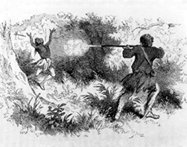Archive for October, 2018
25 Oct 2018

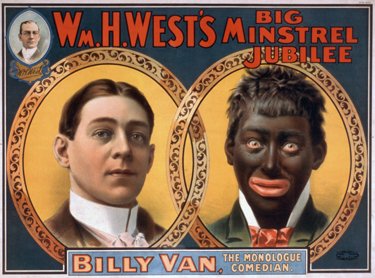
and piss off the SJWs.
Halloween is getting to be downright dangerous in this country. Back in 2015, the wife of Yale’s Silliman College Master Nicholas Christakis, and Associate Master, Erica Christakis, responded to an admonitory pre-Halloween email from the Intercultural Affairs Council — a group of administrators from the cultural centers, Chaplain’s Office and other campus organizations — sent to the undergraduate student body warning against wearing Halloween costumes which could be interpreted as belittling or offensive: no sombreros, no blackface, no turbans, defending freedom of expression and arguing against hypersensitive prohibition and censorship.
Well, Master Nicholas and a black dean were confronted by angry student mobs demanding his firing or resignation. There was a march on President Salovey’s house and a presentation of outrageous radical demands, most of which President Salovey promptly granted. The Yale Administration assured the Christakises that free speech would be upheld, it was solidly behind them, and then quietly got both of them out of Silliman College and out of town. (Professor Nicholas Christakis was paid off for keeping quiet with the award of a prestigious Sterling Professorship a couple years later.) Mrs. Christakis no longer teaches at Yale, and is giving lectures and doing free-lance writing. Boo!
And the PC Halloween Monster strikes again! This time it is NBC Today Host Megan Kelly riding the tumbril in the direction of the stake for, yes! you guessed it, questioning the blasphemous nature of Halloween blackface. Burn, witch, burn!
Roxanne Jones, “a founding editor of ESPN Magazine and former vice president at ESPN,” lays down the law at CNN:
Sometimes “I’m sorry” just doesn’t cut it — a hard lesson that NBC Today show host Megyn Kelly now understands. Reportedly, Kelly’s morning show “Megyn Kelly Today” may be cancelled, according to CNN sources and Variety reports.
Kelly, who never really seemed like a good fit for the NBC morning show, overplayed her popularity earlier this week when she passionately defended people who don blackface costumes for Halloween — a thing that most Americans understand is definitely not okay, unless their intention is to offend.
“But what is racist?” Kelly asked on her show. “Because you do get in trouble if you are a white person who puts on blackface on Halloween, or a black person who puts on whiteface for Halloween. Back when I was a kid that was OK, as long as you were dressing up as, like, a character.”
The backlash was swift. Kelly was roasted across social media and more importantly her colleagues and bosses were appalled by her comments. NBC executives forced Kelly to apologize first, internally to her colleagues, and then to the viewers.
But Halloween is tricky and the blackface flap didn’t die down.
Ironically, for me, the most revealing part of Kelly’s explosive comments was their illumination of her true face as an out-of-the-closet racist, in my opinion.
I didn’t buy Kelly’s innocent act of contrition. Maybe I’ve just become desensitized to these knee-jerk, teleprompter apologies for public misdeeds. Maybe we all have. Maybe we should.
But Kelly shouldn’t be surprised that her racist statements met resistance. And she shouldn’t be surprised that NBC, like so many other employers who have taken action against talent for incidents of racism, has apparently decided that her brand of bigotry is simply not worth the risk anymore. Even her NBC colleague Al Roker, who said Wednesday, “The fact is, she owes a bigger apology to folks of color around the country.”
————————–
Jenée Desmond Harris, at leftist Vox, explains to you ignorant bigots why defending blackface is a prosecutable thought and speech crime.
Put down the black and brown face paint. Step away from the bronzer 12 shades darker than your skin. That is, if you’re at all interested in not being a walking symbol of racism this Halloween.
Wait, what’s wrong with blackface? A lot of people, thankfully, don’t need this question answered. To many, it’s obvious that it’s a lazy, non-funny costume bad idea with a depressing history that is the opposite of celebratory. Each Halloween serves as a reminder that a giant gulf remains between people who understand that blackface is in bad taste, or are willing to defer to black people who tell them so, and people who are still asking “But why?” (You know, the ones who are thinking as they read this, “You say it’s racist but I can tell you right now I’m not racist, so it’s fine if I wear it! Come on, get over it! Stop with the political correctness! I don’t understand how this is offensive! It’s a joke!”)…
For the “why” crowd (and for anyone who feels moved to have a dialogue with one of its members), here’s an explanation of what, exactly, is wrong with wearing blackface, on Halloween or ever:
Blackface is much more than just dark makeup used to enhance a costume.
Its American origins can be traced to minstrel shows. In the mid to late nineteenth century, white actors would routinely use black grease paint on their faces when depicting plantation slaves and free blacks on stage.
To be clear, these weren’t flattering representations. At all. Taking place against the backdrop of a society that systematically mistreated and dehumanized black people, they were mocking portrayals that reinforced the idea that African-Americans were inferior in every way.
According to you, Jenée, but it’s really a lot more complicated, and far less negative than that.
Minstrel shows and blackface performances, it’s true, did include unflattering stereotypes of African Americans, but white performers were not merely donning blackface to mock and belittle colored people. They were commonly doing it in order to become black. White performers wanted to become black in order to perform music with African-American roots and in order to pay affectionate tribute to old-time Southern African-American humor and culture.
When I was a boy, for several years, I grudgingly sacrificed a hour of extra sleep in order to get up and catch Amos n’ Andy re-runs on early morning television. There were things very much other than mockery and condescension that motivated me. There was a fascination in the flavorful and witty colored dialect. There was enormous charm in the very human foibles of the principal characters. And I distinctly admired the absolute brilliance, the polytropic enterprise, and the thoroughgoing rascallity of the Kingfish. Heck, if I’d been able to find examples at my local haberdasher’s, I’d likely have started wearing string ties and a tail coat in emulation of that great man. I loved the Kingfish, and –just like most American– I respected and admired the straight arrow cab driver Amos Jones.
Pre-Politically-Correct America actually had lots of diversity, and Americans loved and enjoyed that diversity. Popular entertainment reveled in exploiting ethnic stereotypes for humor and as an expression of affection. Jewish Molly Goldberg‘s ethnic characteristics were funny, but they were also heart-warming. Brooklyn Irish Chester A. Riley was crude, vulgar, and unmannerly, but he was also tough, loyal, and a good guy underneath it all.
It was the same with the old minstrel shows and Amos n’ Andy, which was a kind of continuation of the former right into the television era. Americans watched them to laugh at the characters and they also loved those characters.
It’s the Left that hates and wants to harm people.
24 Oct 2018


The Atlantic headline says it’s been discovered that the Maya had a zoo, but the real news in this story is the discovery that they were using jaguars in their ritual sacrifices. But the Atlantic wouldn’t want to come down hard on that little detail. That could make the worthy and magnificent Maya just about as bad as that dentist who shot Cecil the lion.
In the Mayan city of Copán, at the base of a 30-meter-tall pyramid, there’s a beautiful stone slab known as Altar Q. The altar is square, and each of its meter-wide faces preserves carvings of four of the city’s 16 rulers, including its final king, Yax Pasaj Chan Yoaat, who commissioned the structure in 776. It was as much propaganda as historical record. Though Yax Pasaj wasn’t part of a dynastic bloodline himself, the altar shows him receiving the scepter of kingship from Copán’s founding ruler, thus proving that he was worthy of ruling. The altar was a statement of his legitimacy.
The jaguars probably helped.
There’s a crypt immediately in front of the altar, which contained the bones of several birds, and 16 big cats—jaguars and pumas (cougars) packed so tightly that the people who first excavated them referred to them as “jaguar stew.†It’s likely that these animals were sacrificed on the altar as emblems of power, one cat for each king.
“It’s hard to imagine this very elaborate ritual in one of the hardest times for the Copán dynasty,†says Nawa Sugiyama, an archaeologist at George Mason University. Yax Pasaj was the last person to rule the city before it collapsed, and his reign was one of political turmoil and environmental degradation. Amid that turmoil, he somehow managed to acquire 16 big cats, even though the surrounding valley was too small to house more than five jaguars, and even though these beasts are hard to find, much less to capture.
Sugiyama thinks she knows how he did it. By analyzing the chemicals within the buried cat bones, she and her colleagues showed that jaguars and pumas likely came to Copán from distant regions and were kept in captivity for most of their lives. The city effectively had its own zoo, which was part of a wide trade network that sucked in wildlife from a larger area. For three centuries, wild animals—including the most formidable carnivores around—were brought in, housed, fed, and eventually used in ritual ceremonies.
RTWT
24 Oct 2018

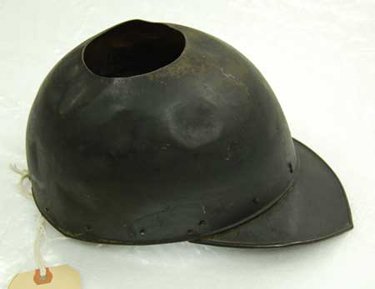
The helmet.
————————-

The gorget.
John Gregory Bourke (1846-1896) enlisted in the Fifteenth Pennsylvania Volunteer Cavalry at the age of 16, and was awarded a Medal of Honor for “gallantry in action” at the Battle of Stones River, Tennessee, in December 1862. He also fought at Chickamauga under George H. Thomas.
After the war, through Thomas, he received an appointment to West Point where he graduated in 1869, and was then assigned as a second lieutenant in the Third U.S. Cavalry. He served with his regiment at Fort Craig, New Mexico Territory, from September 29, 1869 to February 19, 1870.
Bourke was an enthusiastic student of Indian ethnology, on which subject he published a number of studies, and a copious diarist.
He compiled, from his diaries, a military memoir, On the Border with Crook, published in 1892, which is one of the key primary sources on the Indian Wars.
His quarters in New Mexico were simple and rough, he tells us, but they were decorated with a set of three hundred year old Spanish armor.
My assignment was to one of the rooms in the adobe house, an apartment some fourteen by nine feet in area, by seven and a half or eight in height. There was not enough furniture to occasion any anxiety in case of fire: nothing but a single cot, one rocking-chair — visitors, when they came, generally sat on the side of the cot — a trunk, a shelf of books, a small pine washstand, over which hung a mirror of greenish hue, sold to me by the post trader with the assurance that was French plate. I found afterward that the trader could not always be relied upon, but I’ll speak of him at another time. There were two window curtains, both of chintz; one concealed the dust and fly specks on the only window, and the other covered the row of pegs upon which hung sabre, forage cap, and uniform.
In that part of Arizona fires were needed only at intervals, and, as a consequence, the fireplaces were of insignificant dimensions, although they were placed, in the American fashion, on the side of the rooms, and not, as among the Mexicans, in the corners. There was one important article of furniture connected with fireplace and which I must make mention—the long iron poker with which, on occasion I was want to stir up the embers, and also to stir up the Mexican boy Esperidion, to whom, in the wilder freaks of my imagination, I was in the habit of alluding as my “valet.â€
The quartermaster had recently received permission to expand “a reasonable amount†of paint upon the officers’ quarters, provided the same could be done by labor of the troops. …
It goes without saying that the work was never any too well done, and in the present case there seemed to be more paint scattered about my room than would have given it another coat. But the floor was of rammed earth and not to be spoiled, and the general effect was certainly in the line of improvement. Colonel Dubois, our commanding officer, at least thought so, and warmly congratulated me on the smug look of everything and added a very acceptable present of a picture—one of Prang’s framed chromos, a view of the Hudson at the mouth of the Esopus creek – which gave a luxurious finish to the whole business. Later on, after I had added an Apache bow and quiver, with its complement of arrows, one or two of the bright, cheery Navajo rugs, a row of bottles filled with select specimens of tarantulas, spiders, scorpions, rattlesnakes and others of the fauna of the country, and hung upon the walls a suit of armor which had belonged to some Spanish foot-soldier of the sixteenth century, there was a sybaritic suggestiveness which made all that has been related of the splendors of Solomon and Sardanapalus seem commonplace.
Of that suit of armor I should like to say a word: it was found by surgeon Steyer, of the army, enclosing the bones of a man, in the arid country between the waters of the Rio Grande and the Pecos, in the extreme southwest corner of the State of Texas, more than 20 years ago. Various conjectures were advanced and all sorts of theories advocated as to its exact age, some people thinking that it belonged originally to Coronado’s expedition, which entered New Mexico in 1541. My personal belief is that belong to the expedition of Don Antonio Espayo or that of Don Juan de Oñate, both of them came to New Mexico about the same date —1581-1592—and travelled down the Concho to its confluence with the Rio Grande, which would have been just on the line where the skeleton in armor was discovered. There is no authentic report to show that Coronado swung so far to the south; his line of operation took in the country farther to the north and east, and there are the best of reasons for believing that he was the first white man to utter the fertile valley of the Platte, not far from Plum Creek, Nebraska.
But, be that as it may, the suit of armor — breast and back plates, gorget, and helmet — nicely painted and varnished, and with every tiny brass button duly cleaned and polished with acid and ashes, added not a little to the looks of the den which without them would’ve been much more dismal.
For such of my readers may not be up on these matters, I may say that iron armor was abandoned very soon after the Conquest, as the Spaniards found heat of these dry regions too great to admit of their wearing anything so heavy; and they also found that like cotton batting “escaupiles†of the Aztec served every purposes as a protection against the arrows of the naked savages by whom they were now surrounded.
—————–
Parts at least of Bourke’s Spanish armor have survived, and I found some discussion on the Internet in a discussion thread at Above Top Secret:
The few records of the armor that exist came from U.S. cavalry officer and anthropologist Capt. John Gregory Bourke, who was given the gorget, helmet, and a breast- and backplate in 1870, from an army doctor who claimed to have found them “enclosing the bones of a man in the arid country between the waters of the Rio Grande and the Pecos.â€
Bourke took the armor with him from post to post throughout the West during his career, losing the breast and backplates to thieves in Arizona along the way.
But before his death in 1896, Bourke gave the helmet and gorget to a judge’s wife in Nebraska, and by the early 20th century, it was in the possession of an Omaha attorney, in whose family it remained until it was donated to a museum in 1961, and then to the state historical society.
The assumption is the armor is Spanish, that would be the most likely scenario as it dates to the appropriate period.
Historical records describe the equipment used by Spanish soldiers at that time, but the team found that it included little armor, the Spanish instead having used mostly padded leather or shirts of chain mail.
“It just is not very much like armor known to have been used by colonial Spanish forces,†Bleed said of Bourke’s armor of iron scales.
“The Spanish apparently had some (chain) mail, but the idea of taking a fabric and attaching little fish scales to it, this is not something they did.â€
It’s too bad the breast plate and back were lost as they would shed more light on where this came from.
RTWT
23 Oct 2018

From Henry Bernatonis:
A very short gun story.
A wild eyed (and butt ugly) old woman walked into a crowded bar in downtown Washington, D.C. waving an un-holstered pistol and yelled out;
“I have a .45 caliber Colt 1911, with a seven round magazine, plus one in the chamber.
I want to know who’s been sleeping with my husband?”
A female voice from the back of the room called out,
“You Need More Ammo, Mrs. Clinton”.
23 Oct 2018


Samples of miltos, including a sixteenth century Ottoman example (e), and a control sample of yellow oxide (b).
Andrew Masterson, in Cosmos magazine, reports that modern researchers are attempting to pin down the exact identity of an intriguing Roman mineral.
From ancient Greek and Roman source texts it is possible to conclude that in the classical world a mineral, a powder known as miltos, was something of a wonder substance.
Miltos – referred to in the works of writers such as Theophrastus, Dioscorides and Pliny – was red, fine-grained, and made up mostly of iron-oxide.
By the time Theophrastus, a Greek philosopher and proto-botanist, wrote about it in the third century BCE, it was already a mineral validated by antiquity. Its use is attested to in Mycenaean clay tablets, inscribed in the script known as Linear B and dating from the second millennium BCE.
The variety of applications for which it was used was broad indeed. According to a team of researchers writing in the Journal of Archaeological Science: Reports, it was used “as a pigment, as a cosmetic, in ship maintenance, agriculture and medicineâ€. …
The ancient texts made it clear that miltos, unlike some other types of mineral, could be found, and mined, in only a few places in Graeco-Roman world – namely Kea, in the Cyclades, Lemnos in the northeast Aegean, and Cappadocia in Turkey. This specificity meant identifying the substance was simple: it was the red dusty stuff found at the mine sites, and easily matched, therefore, with older samples held in museums and galleries.
RTWT
23 Oct 2018
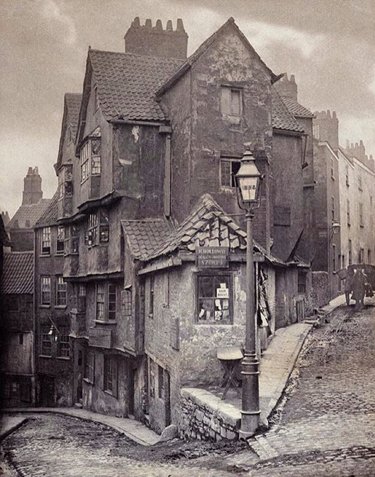
————————————–

The intersection of Steep and Trenchard Street, Bristol, England, 1866 and now.
22 Oct 2018


I have compiled all the comments on this web-site loading slowly below, so that potential technical support can have a handy reference.
My own observations:
I have no clue what the problem some people (and only some people) seem to be having could be.
I use Chrome for blogging and I look at the blog all the time in Chrome, and it loads normally for me. My wife finds no problem either.
I did reduce the number of posts on page one which should slightly speed things up.
I now intend to ask for technical advice.
———————————-
2018/10/09 at 5:51 pm:
Your website has become really, really slow. Last few days. So slow sometimes I just cancel the load and go somewhere else.
——————
2018/10/11 at 3:03 pm:
Thursday, 10/11, 3:00 p.m. EST: unusable. 1:16 (one minute, 16 seconds) for your page to load once the name resolution completed. Just as long to access this comment page. No problems with any other websites.
——————
2018/10/13 at 9:42 am:
It’s working well now! Much, much better.
I’ve been using both Chrome and Safari on a Mac – operating system and browsers all latest versions. Chrome has been flakey with High Sierra, but the slow load was only your site, until last night.
You can email me to discuss offline if you like, and I’m happy to provide feedback going forward.
——————
2018/10/13 at 5:55 pm:
I spoke too soon. Now, almost 6:00 p.m. Saturday, it’s back to 1:16 from clicking the comment link to the page load.
Something’s very wrong.
——————
2018/10/13 at 10:06 pm:
Update: right now it’s really, really slow on Chrome and Safari, but
speedy on Firefox.
Mac OS X 10.13.6 (High Sierra)
Chrome Version 69.0.3497.100 (Official Build) (64-bit)
Safari Version 12.0 (13606.2.11)
Firefox 62.0.3 (64-bit)
(I believe these are all latest versions)
I can’t explain it.
——————
2018/10/16 at 7:33 am:
I know, it’s weird. I tried it again just now, it seemingly NEVER loads on Safari, and takes forever on Chrome, but it’s speedy with Firefox. As I said, latest Mac OS, latest Chrome, latest Safari, latest Firefox. The browser status when it’s taking a long time is “Connecting….†It eventually connects, but ever page load to your blog takes as long.
I’d really like to know if it’s me, what it is!
——————
2018/10/16 at 12:24 pm:
On Chrome on my home desktop has been loading slowly for a week or two.
——————
2018/10/16 at 11:42 am:
Use Chrome . No issues .
——————
2018/10/16 at 5:23 pm:
on Safari it has stopped loading all together when I click my bookmark. But if I manually type in url it will load. On Chrome it loads very slowly but eventually does load.
——————
2018/10/16 at 5:59 pm:
Usually access using Android phone with Chrome. Has been exceeding slow to load the last couple weeks but is ok after it does.
Tried it with Brave which I recently installed. Handshake took a few seconds but loaded quickly. Never had an issue with Firefox on laptop.
——————
2018/10/16 at 6:50 pm:
It is just fine on Firefox but videos linked from facebook don’t even show on the page.
——————
2018/10/16 at 7:05 pm:
Chrome… about two weeks ago it started to go very slow. Takes about 30 seconds to open the home page. Clicking here just now to comment also took another 30 seconds.
But like the old catsup commercial… anticipation was worth it.
——————
2018/10/19 at 12:44 pm:
Loads like ye olde greased lightning.
22 Oct 2018


The Very Model of a Modern-Age Millennial
by Meg Elison
I am the very model of a modern-age millennial,
I’ve got no cash, no house, no kids, and student debt perennial,
I know the rules of Tinder, and I’m not sold on monogamy
(For what it’s worth I think that stems from troubles ‘tween my mom and me)
I’m very well acquainted, too, with matters on the gender front
Myself, I am nonbinary; your labels I so do not want
Been disillusioned by my expectations with a lot o’ stuff,
The skills with which I am equipped for life are frankly not enough
My job prospects are hobbled by insistence on a living wage
Compete at entry level with some washed-up folks at twice my age
In matters of identity, employment and such petty ills
I am the very model of a modern-age millennial
An unprecedentedly intimate and comprehensive glimpse at the breadth and diversity of one of world literature’s most vital, adventurous presences.
On Monday I killed Applebee’s, on Tuesday I axed country clubs
I’ve never bought a diamond and I have no use for cashmere gloves
I quote dank internet memes in lieu of sharing actual thoughts
For earnestness has been passé since sometime in the early aughts
Still advertisers flail and fail to capture all my buying power
(The sum of which amounts to renting GIG cars by the paltry hour)
I’m subject to the bleak nostalgia of Generation Xers
And YouTube sensibilities adored by web-savvy youngsters
So I get to the take the blame for our country’s tanked economy
While fighting for my basic rights and bodily autonomy
In short I’m fucked in matters from the vital to the trivial
I am the very model of a modern-age millennial
In fact, when I know what is meant by “social justice warriorâ€
When I can tell at sight a fascist MRA conspirator
When such affairs are treated as unsolvable new mysteries,
I shake my head and wonder if the Boomers studied history
When I have learnt what progress has been made and then just flushed away
My generation’s best bet looks like playing Fortnite drunk all day
In short, if you’re angry right now and spewing aged white vitriol
Remember you created me: the modern age millennial
For I’m the generation raised upon the game Monopoly
You’re hoarding all the wealth and jobs and mock me for my poverty
So now I’m skewing socialist with discourse quite ungenial
Please check your local ballots for the modern-age millennial
HT: McSweeney’s via Karen L. Myers.
21 Oct 2018

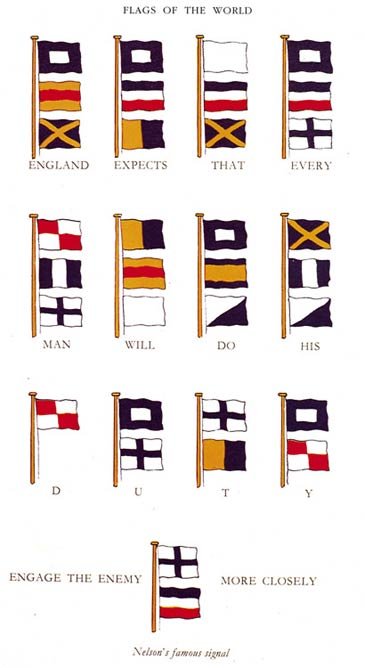
Sent at 11:45 A.M., just as Nelson’s two parallel columns of ships prepared to break through the French & Spanish line.
Wikipedia:
At four o’clock in the morning of 21 October Nelson ordered the Victory to turn towards the approaching enemy fleet, and signaled the rest of his force to battle stations. He then went below and made his will, before returning to the quarterdeck to carry out an inspection. Despite having 27 ships to Villeneuve’s 33, Nelson was confident of success, declaring that he would not be satisfied with taking fewer than 20 prizes. He returned briefly to his cabin to write a final prayer, after which he joined Victory’s signal lieutenant, John Pasco.
Mr Pasco, I wish to say to the fleet “England confides that every man will do his duty”. You must be quick, for I have one more signal to make, which is for close action.
Pasco suggested changing ‘confides’ to ‘expects’, which being in the Signal Book, could be signalled by the use of a single flag, whereas ‘confides’ would have to spelt out letter by letter. Nelson agreed, and the signal was hoisted.
As the fleets converged, the Victory’s captain, Thomas Hardy suggested that Nelson remove the decorations on his coat, so that he would not be so easily identified by enemy sharpshooters. Nelson replied that it was too late ‘to be shifting a coat’, adding that they were ‘military orders and he did not fear to show them to the enemy’. Captain Henry Blackwood, of the frigate HMS Euryalus, suggested Nelson come aboard his ship to better observe the battle. Nelson refused, and also turned down Hardy’s suggestion to let Eliab Harvey’s HMS Temeraire come ahead of the Victory and lead the line into battle.
Victory came under fire, initially passing wide, but then with greater accuracy as the distances decreased. A cannonball struck and killed Nelson’s secretary, John Scott, nearly cutting him in two. Hardy’s clerk took over, but he too was almost immediately killed. Victory’s wheel was shot away, and another cannonball cut down eight marines. Hardy, standing next to Nelson on the quarterdeck, had his shoe buckle dented by a splinter. Nelson observed ‘this is too warm work to last long’. The Victory had by now reached the enemy line, and Hardy asked Nelson which ship to engage first. Nelson told him to take his pick, and Hardy moved Victory across the stern of the 80-gun French flagship Bucentaure. Victory then came under fire from the 74-gun Redoutable, lying off the Bucentaure’s stern, and the 130-gun SantÃsima Trinidad. As sharpshooters from the enemy ships fired onto Victory’s deck from their rigging, Nelson and Hardy continued to walk about, directing and giving orders.
Shortly after one o’clock, Hardy realised that Nelson was not by his side. He turned to see Nelson kneeling on the deck, supporting himself with his hand, before falling onto his side. Hardy rushed to him, at which point Nelson smiled
Hardy, I do believe they have done it at last… my backbone is shot through.
He had been hit by a marksman from the Redoutable, firing at a range of 50 feet (15 m). The bullet had entered his left shoulder, passed through his spine at the sixth and seventh thoracic vertebrae, and lodged two inches (5 cm) below his right shoulder blade in the muscles of his back.
Nelson was carried below by sergeant-major of marines Robert Adair and two seamen. As he was being carried down, he asked them to pause while he gave some advice to a midshipman on the handling of the tiller. He then draped a handkerchief over his face to avoid causing alarm amongst the crew. He was taken to the surgeon William Beatty, telling him
You can do nothing for me. I have but a short time to live. My back is shot through.
Nelson was made comfortable, fanned and brought lemonade and watered wine to drink after he complained of feeling hot and thirsty. He asked several times to see Hardy, who was on deck supervising the battle, and asked Beatty to remember him to Emma, his daughter and his friends.
Hardy came belowdecks to see Nelson just after half-past two, and informed him that a number of enemy ships had surrendered. Nelson told him that he was sure to die, and begged him to pass his possessions to Emma. With Nelson at this point were the chaplain Alexander Scott, the purser Walter Burke, Nelson’s steward, Chevalier, and Beatty. Nelson, fearing that a gale was blowing up, instructed Hardy to be sure to anchor. After reminding him to “take care of poor Lady Hamilton”, Nelson said “Kiss me, Hardy”. Beatty recorded that Hardy knelt and kissed Nelson on the cheek. He then stood for a minute or two before kissing him on the forehead. Nelson asked, “Who is that?”, and on hearing that it was Hardy, he replied “God bless you, Hardy.” By now very weak, Nelson continued to murmur instructions to Burke and Scott, “fan, fan … rub, rub … drink, drink.” Beatty heard Nelson murmur, “Thank God I have done my duty”, and when he returned, Nelson’s voice had faded and his pulse was very weak. He looked up as Beatty took his pulse, then closed his eyes. Scott, who remained by Nelson as he died, recorded his last words as “God and my country”. Nelson died at half-past four, three hours after he had been shot.

Coloured engraving by J. Heath after Benjamin West, The death of Lord Nelson aboard HMS Victory at the battle of Trafalgar, 1811.
/div>

Feeds
|














